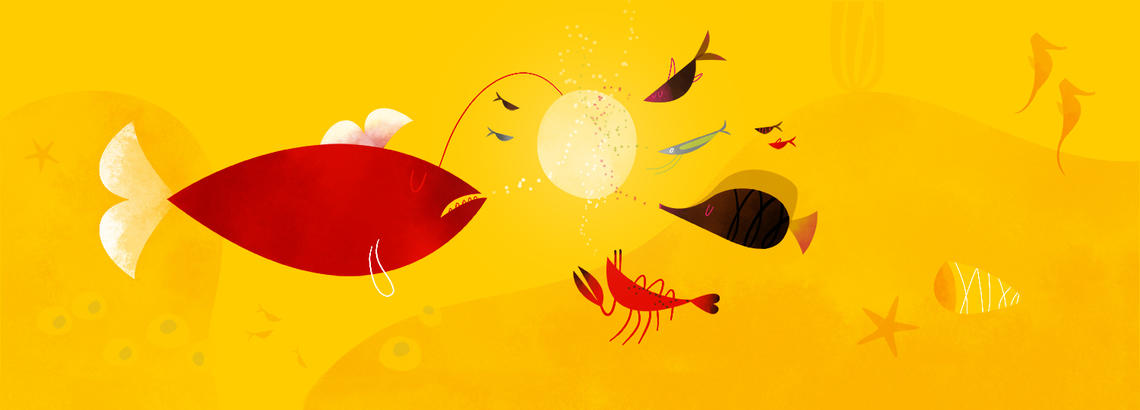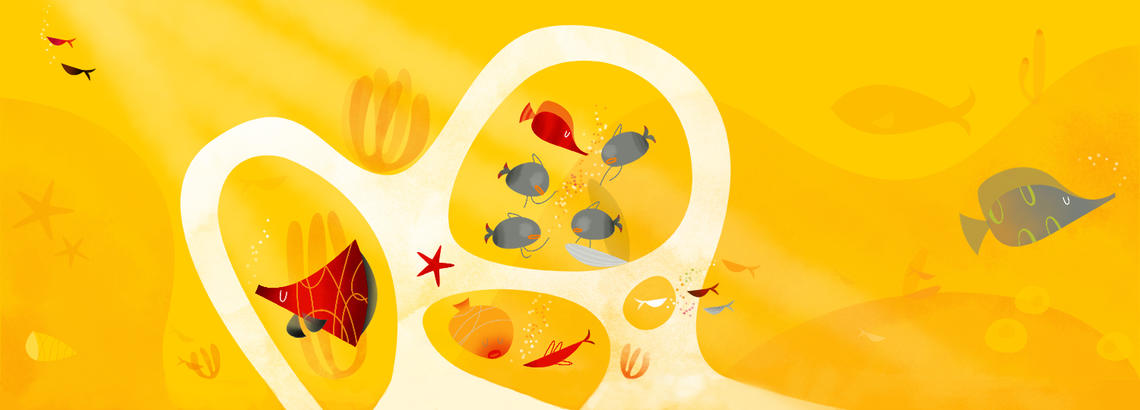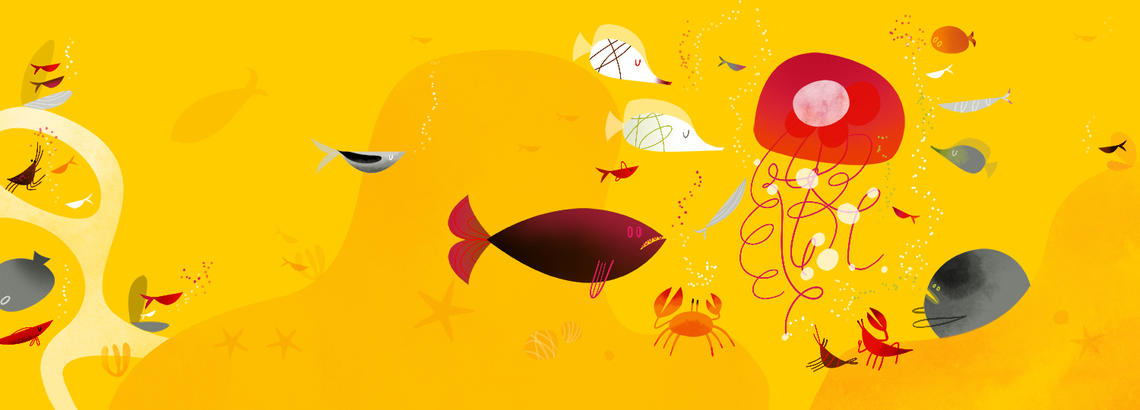
The right space can encourage collaboration and teamwork.
Nov. 1, 2017
The modern classroom doesn’t look much like the traditional one. Giant interactive screens bring information wherever it’s needed. Walls are pushed out of the way to open up space and conversation. Groups of students solve problems in all kinds of ways – at specially built collaborative labs, sitting around tables using whiteboards or lounging on cheerful seating in bright atriums.
With the wide-open spaces and cutting-edge technology at the Taylor Institute for Teaching and Learning and the brand-new Canadian Natural Resources Limited Engineering Complex, UCalgary is creating spaces that help advance how we teach and learn.
Classrooms and buildings across campus are being transformed to provide more room for peer-to-peer learning and technologies. These optimized spaces are making it easier to create new, more engaging learning experiences for students, from ‘speed dating’ to pick teammates to taking time to sit quietly after discussing a difficult history.
There are no ping-pong tables or pinball machines, but computer science and business students are coming up with startup ideas in wide-open spaces, just like they do in Startup Central, Silicon Valley.
Students taking Principles of Entrepreneurship in UCalgary's Haskayne School of Business and those enrolled in Software Entrepreneurship in the Faculty of Science come together in a “collision course” that mimics real life, where the two disciplines work hand-in-hand to develop and market new software, apps or other technology.
“It takes a lot of back and forth to develop a software-based startup,” says Frank Maurer, a computer science professor who co-teaches the course, the first of its kind in Canada. “You can’t do it in a silo.”
And you can’t do it in a traditional classroom.
“It takes a lot of back and forth to develop a software-based startup. You can’t do it in a silo.”
Over the course of the semester, students go to separate but nearby classrooms for discipline-specific lectures but they spend the bulk of their time working in open space with giant computer screens and at tables throwing around ideas and plotting how to commercialize their startups. Students also hear from a series of established entrepreneurs who come to class as guest speakers. Then there's the ‘speed dating’ process early on in the semester where students pick their teammates.

The right space can encourage collaboration and teamwork.
“It's more collaborative and more discussion-oriented than other classrooms where you stand at the front of the class and talk to them,” says Maurer. “It’s a more integrated approach where people discuss things and problem-solve.” In fact, a big chunk of a student’s mark in based on teamwork rather than individual work.
“The students reported being energized by the open space, natural lighting and semi-structured work environment where the technology was adapted to what they wanted to do instead of having to change what they did for the technology,” says Chad Saunders, assistant professor in entrepreneurship at Haskayne. At the end of the first class in 2017, several groups considered commercializing their ideas or working with their teams to come up with fresh ideas in the future.
“We need to recognize the impact of this type of experiential learning is not always immediate,” says Saunders. “In our research, we’ve begun to address this through the use of longitudinal studies that track these impacts over time, often years."
"Where you work has a substantial effect on how you work."
While there are no plans to add any stress-busting ping pong tables to the mix, the course will continue in open-space classrooms using the same guiding principles. “Where you work has a substantial effect on how you work,” says Maurer.
Health sciences faculty used to stand at the front of the room to give a lecture, maybe a PowerPoint presentation, on material their students had read in their textbooks. But team-based learning provides students and their teachers a far more meaningful experience in the classroom.
“Two years ago, I’d come into a class with 130 students and maybe 30 were showing up,” says Linda Duffett-Leger, assistant professor in the Faculty of Nursing. “With team-based learning we’re getting almost 100 per cent attendance.”
Students are put into groups at the beginning of the semester and given a list of readings they’re expected to finish before each class. Once in class, instead of having the readings regurgitated in a lecture, the students discuss real-life scenarios in their groups.
For example, they may watch a video showing nurses dealing with a patient who has a postpartum hemorrhage. “They see a nurse providing a report to the incoming nurse who then goes in and does an assessment with mom,” says Duffett-Leger. “Based on what they see in the video they need to make some critical judgments and decisions.”
“It’s like asking a child to eat nutritiously but giving them a steady diet of pizza.”
Instead of just listening to a lecture, the students take the knowledge from their readings to make critical decisions. “We expect our students to develop these critical thinking skills but often we don’t apply it in a way that’s necessarily meaningful to them or challenges those abilities,” says Duffett-Leger. “It’s like asking a child to eat nutritiously but giving them a steady diet of pizza.”
The students are also graded differently. Their marks are divided into three components – individual assessment, team assessment and a peer contribution mark which puts some value on the teamwork and makes students accountable to each other for their attendance and participation in class.
Some of the key aspects of team-based learning were developed by engineers for engineering students, but it’s “catching on” in health disciplines all over the world. “The instructors I’ve introduced this to say they can’t go back,” says Duffett-Leger. “It changes the energy in the room. It makes it much more fun for everybody. Getting up and lecturing somebody for three hours can be painful for everybody involved.”
How do you spur conversation among students to help reconcile a tragic history and make changes to improve the present? Since Canada’s Truth and Reconciliation Commission, more people are asking this important question and trying to come up with answers.
“Often there’s a lot of pain involved in bringing out the dark truth,” says Yvonne Poitras Pratt, an assistant professor at the Werklund School of Education. “It’s important to have an appropriate space to honour the difficult work we are doing and to allow those emotions to air.” Working with colleagues,she helped design and teaches a new Masters interdisciplinary program, Indigenous Education: A Call to Action, part of reconciliatory pedagogy in Canada.
“These are dark topics and they become even more difficult when you’re in a really confined space.”
Poitras Pratt, one of seven Indigenous faculty members at the school, also teaches a mandatory Indigenous education course to undergraduate students, sometimes in a windowless, cramped classroom. “We’re talking about residential schools, some of the abuse from the religious organizations, the dehumanization of people,” she says. “These are dark topics and they become even more difficult when you’re captured in a really confined learning space.”
Her research into teaching difficult subjects in that type of classroom helped design the graduate classbeing taught in the bright and airy Taylor Institute for Teaching and Learning. “Students have the freedom to sit and reflect on the stairs or mull things over with peers in the hanging pods. They have all kinds of places to go on their own or sit with someone,” says Poitras Pratt. “Students need to be able to step away from what can be emotionally intensive work.”

Open, naturally lit spaces can make it easier to discuss difficult topics.
As well as having abundant natural light, the space is abundantly flexible. The walls, technology and furniture can be easily and quickly moved to suit the subject matter – theories of decolonization in the morning and creative expression in the afternoon. “We transform the space all the time,” she says.
The class, which includes both Indigenous and non-Indigenous students from different professions, also travels to Siksika First Nation, just east of Calgary, to visit a residential school (that’s now a community college), to take part in smudging and other ceremonies, and to spend time with Elders.
“We’re moving our theoretical learning into practice in this class. We’re making sure that it’s not just learning from books, but its real life experiential learning that can be transformative,” says Poitras Pratt. “We’re trying to make societal impact.”
Every year for many years, Erin Sullivan was determined to jazz up a couple of very dry but very important lectures for her students in General Chemistry: Structure and Bonding. And every year she’d watch as her students struggled to comprehend how to draw and label 3D molecules on paper.
“There was a lot of disengagement, students sitting back and saying ‘I don’t understand this or I don’t like this,’" says Sullivan, an instructor in UCalgary's Department of Chemistry. "Meanwhile, I was explaining ‘This molecule is called a tetrahedron because it looks like a tetrahedron.' I hated those two lectures.”
But knowing your tetrahedron from a trigonal planar is crucial for students taking any more chemistry or biochemistry courses – they need to know where particular atoms are located inside particular molecules to understand how reactive that molecule is going to be in any given scenario.
Then came the collaboration carts – 50-inch touch screens loaded with interactive simulations of molecules and a virtual whiteboard to name them all. Sullivan doesn’t need to stand at the front of the room and lecture anymore, or even give the students a lot of direction. The students, in groups, just start engaging with the screen.
"It prompts discussion and opens debate instead of just getting them to fill in the blanks.”
“They click a box that tells them the name of the shape and they can add more bonds or take bonds away,” says Sullivan. “As a group they’re going ‘Oh cool, look, if I press this button I can see what the shape is called.’ It prompts discussion and opens debate instead of just getting them to fill in the blanks.”
Her teaching assistants (TAs), who used to answer endless questions during the two lectures, are doing a lot more listening than talking. “With this activity I actually had TAs turn to me and say ‘Why are we even here? They aren’t asking any questions!’” says Sullivan. She and her TAs “float through the room” seeing what students are struggling with so they can adjust the activities on the screen.
So far, Sullivan has taught a couple semesters with the collaboration carts. “We’ve seen a huge difference in engagement,” she says. “Consistently more than 95 per cent of students are saying they enjoyed and learned on average three new things from this activity.”
When you walk into the new UCalgary engineering complex for the first time, you feel – immediately – like you belong. With the new Canadian Natural Resources Limited Engineering Complex, the Schulich School of Engineering transformed five existing engineering buildings into one big, bright, cohesive space that invites you to sit down and hang out for a while, whether or not you have a class.
“We’re finding that people are coming to the engineering complex as a destination, as a place they can work, talk with their friends in the atrium in-between or after classes,” says Bill Rosehart, dean of the school. “It supports the student experience and culture and creates a more inclusive and welcoming environment. It’s not any one room or any one space, it’s really how it all comes together as an entity.”
That entity includes two floors of state-of-the-art research labs to further foster high-impact research. “They’re quickly becoming some of the most collaborative research spaces in Canada,” says Rosehart. And three floors of new teaching and learning spaces provide more hands-on and experiential learning opportunities for students. They’re the result of intensive analysis of best practices and a commitment to student success and accommodating different learning styles. The faculty includes many experts in designing, adapting and using learning spaces that go beyond textbooks and lecture halls.

Spaces that are designed to be welcoming and inclusive encourage learning.
Learning spaces accommodate “deep and rich collaborations” among students and professors, says Rosehart. Instead of only sitting in a lecture hall, students can solve problems sitting with teams at tables and using whiteboards, like they’ll do when they graduate. “Students work in groups with the teaching team walking around to mentor the students,” says Rosehart. “Students get both peer-to-peer learning experiences and one-on-one support from our faculty members.”
There’s an entire wing devoted to the many different student teams at Schulich, with space for groups building everything from solar cars to concrete toboggans. When you wander into the large lounge you’ll see students studying together in one spot, a student association pop-up presentation in another, or a speaker from industry taking about how to get a job. “There’s a real mix of activity," says Rosehart.
And, there’s more than a little nostalgic whimsy. The new complex gives a nod to the university’s history by using some old exterior walls in the interior and incorporating an original 1960s staircase from an old engineering building. Back then it was mostly male students climbing those stairs. These days, a growing number of women are studying engineering in the new Schulich complex.
“It’s a space where there’s a spot for everybody,” says Rosehart. And building inclusivity into the complex is “moving the needle” in terms of student success and increasing diversity in the faculty. “When students start at Schulich School of Engineering we want them to be able to finish and we’re seeing that the space is helping.”
Participate in a research study
– – – – –
Dr. Frank Maurer, PhD, computer science professor and head of the Agile Software Engineering (ASE) group at UCalgary, joined the Faculty of Science in 1997. ASE conducts industry-oriented research on immersive analytics and application engineering for digital surfaces. Read more about Frank
Dr. Chad Saunders, PhD, joined UCalgary's Haskayne School of Business as an assistant professor in 2007 and holds adjunct appointments with the Department of Community Health Sciences and the Department of Medicine at the Cumming School of Medicine, where he is the eHealth Services and Strategy Lead with the healthcare innovation incubator the Ward of the 21st Century. Read more about Chad
Dr. Linda Duffett-Leger, PhD, assistant professor in UCalgary's Faculty of Nursing, researches how to reduce the economic and human costs associated with chronic illness by developing innovative health promotion and disease prevention strategies and technologies. Read more about Linda
Dr. Yvonne Poitras Pratt, PhD, is an assistant professor in UCalgary's Werklund School of Education, where she teaches courses in Indigenous Education and adult education. Yvonne's research concentrates on the multiple ways in which transformative learning can be invoked within classrooms and at the community level through experiential learning and creative imaginings. Yvonne is of Métis ancestry with family in the Fishing Lake Métis Settlement in Alberta. Read more about Yvonne
Erin Sullivan is an instructor in UCalgary's Department of Chemistry. Prior to this, she worked as a Post-Doctoral Fellow at UCalgary and as a Laboratory Instructor at Mount Royal University. She has a PhD in organic chemistry from the University of Alberta and a BSc in organic chemistry, with honours, from Mount Allison University.
Bill Rosehart is the dean of the Schulich School of Engineering and has recently been inducted as Fellow into the Canadian Academy of Engineering for his commitment to innovation in teaching and learning. Under Rosehart’s leadership, the school has launched new programs and opened the new Canadian Natural Resources Limited Engineering Complex. Rosehart’s strategic vision is to support student success, foster diversity in engineering and promote research that makes a difference. Read more about Bill